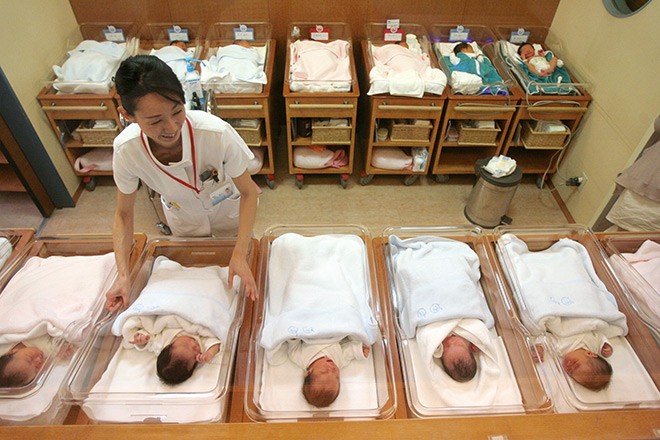By TOKO TANAKA/ Staff Writer
June 6, 2020 at 18:03 JST
 Newborns at a maternity clinic in Fukuoka’s Chuo Ward (Asahi Shimbun file photo)
Newborns at a maternity clinic in Fukuoka’s Chuo Ward (Asahi Shimbun file photo)
Japan’s fertility rate, or average number of children a woman is expected to give birth to in her lifetime, dropped to 1.36 in 2019, going below the 1.40 mark for the first time in eight years.
It marked the fourth consecutive year of decline, according to data released by the Ministry of Health, Labor and Welfare on June 5.
The fertility rate for 2019 slid by 0.06 point from the figure for 2018, significantly down from the 0.01 point level of the preceding three years.
The fertility rate of 1.36 put Japan far from the target of 2.07, the level needed to maintain the population.
By prefecture, Okinawa had the highest fertility rate at 1.82, while Tokyo reported the lowest at 1.15.
The number of children born in Japan in 2019 came to 865,234, a decrease of 53,166 from the previous year and the lowest figure since 1899, when the government began compiling such data.
In contrast, there were 1,381,098 deaths in 2019, the largest since the end of World War II.
The natural population decline was 515,864 in 2019, which was calculated by deducting the number of births from the number of deaths, setting a record drop.
A shrinking pool of people who are able to reproduce, coupled with marriages among those of reproductive age later in life, are the primary factors behind the decline, say experts.
The number of women aged 25 to 39, the age bracket deemed most suitable for starting families, decreased by 2.0 percent over the year.
The average age for first marriage among men was 31.2, and 29.6 for women, for the first increase in six years for both genders.
The average age for women to give birth to their first child has hovered around 30.7 since 2015.
The ministry said a key reason for the slide in the number of children born in 2019 resulted from the fact that there were 20,471 fewer marriages in 2018 than in 2017, or a decrease of 3.4 percent.
In 2019, the number of marriages increased for the first time in seven years to 598,965 as many couples apparently wanted to tie the knot in Reiwa, the new imperial era that began in May 2019.
The government had defined the five years through 2020 as a period for intensive measures to raise birthrate figures.
In an outline review in May, the first in five years, the government maintained a goal of reaching 1.8 for the “desired birthrate,” or the rate expected if young people’s wishes to tie the knot and produce offspring comes true, by 2025.
Hiroshi Kito, president of the University of Shizuoka and an expert on population issues, said Japan needs to work harder to become a society free of gender discrimination if it is to reverse the trend.
“It is important to give financial assistance to families raising children,” he said. “But the number of births will not go up unless we create a society where men and women are equal, no matter how long it takes to achieve that goal.”




















Here is a collection of first-hand accounts by “hibakusha” atomic bomb survivors.
A peek through the music industry’s curtain at the producers who harnessed social media to help their idols go global.
Cooking experts, chefs and others involved in the field of food introduce their special recipes intertwined with their paths in life.
A series based on diplomatic documents declassified by Japan’s Foreign Ministry
A series about Japanese-Americans and their memories of World War II